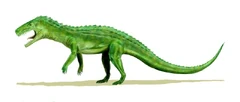| Euparkeria | |
|---|---|

| |
| An artist's illustration of Euparkeria capensis | |
| Scientific classification | |
| Kingdom: | Animalia |
| Phylum: | Chordata |
| Class: | Sauropsida |
| Family: | Euparkeriidae |
| Genus: | †Euparkeria Broom, 1913 |
| Species: | †E. capensis |
| Type species | |
| †Euparkeria capensis Broom, 1913 | |
Euparkeria, was a small African reptile of the early Triassic period who was an ancestor of archosaurs, a group of animals that includes dinosaurs, crocodiles and birds. Euparkeria was quick on its feet and walked on two feet. It had a light, lean body with a long tail and a head filled with tiny, needle-sharp teeth.
Palaeobiology

Euparkeria Skull
Euparkeria had a light, lean body, long tail, and a small skull with tiny, needle-like teeth. It probably fed on insects and any other small animals that it could find on the forest floor, and would have periodically shed its teeth in order to keep them sharp. The first fossils were found in South Africa in 1913, but better specimens were found in 1924. Euparkeria was one of the smaller reptiles of its time, with the adults reaching 60 centimetres (24 in); the size of a large lizard. Euparkeria had relatively long hind legs, and may have been semi-bipedal, able to move using only its hind legs when running quickly. It lived alongside primitive thecodonts, archosaurs, and some of the mammal-like reptiles like Placerias.
This tendency towards bipedal locomotion makes Euparkeria one of the earliest reptiles to walk on two legs, a feature that would be retained in some dinosaurs and early Crurotarsi. Like many early archosaurs, it had a row of relatively light bony plates along its back and tail. Another means of defence that Euparkeria possessed was a sharp claw on its thumb, which could have been used as a weapon in close combat. Comparisons between the scleral rings of Euparkeria and modern birds and reptiles indicates that it may have been nocturnal, supporting the idea that early archosaurs adapted to dim light. However, as Euparkeria may have been a polar animal, it likely lived under different lighting conditions from typical archosaurs and may not have inherited its nocturnal adaptations from a common ancestor with archosaurs.
In Popular Culture

Euparkeria from Walking With Monsters
Euparkeria was featured in the BBC television program Walking With Monsters, incorrectly identifying it as the ancestor of all dinosaurs. Euparkeria was not the true ancestor of dinosaurs; however, it was related to the dinosauromorphs and Saltoposuchus, a possible ancestor of the dinosaurs.
